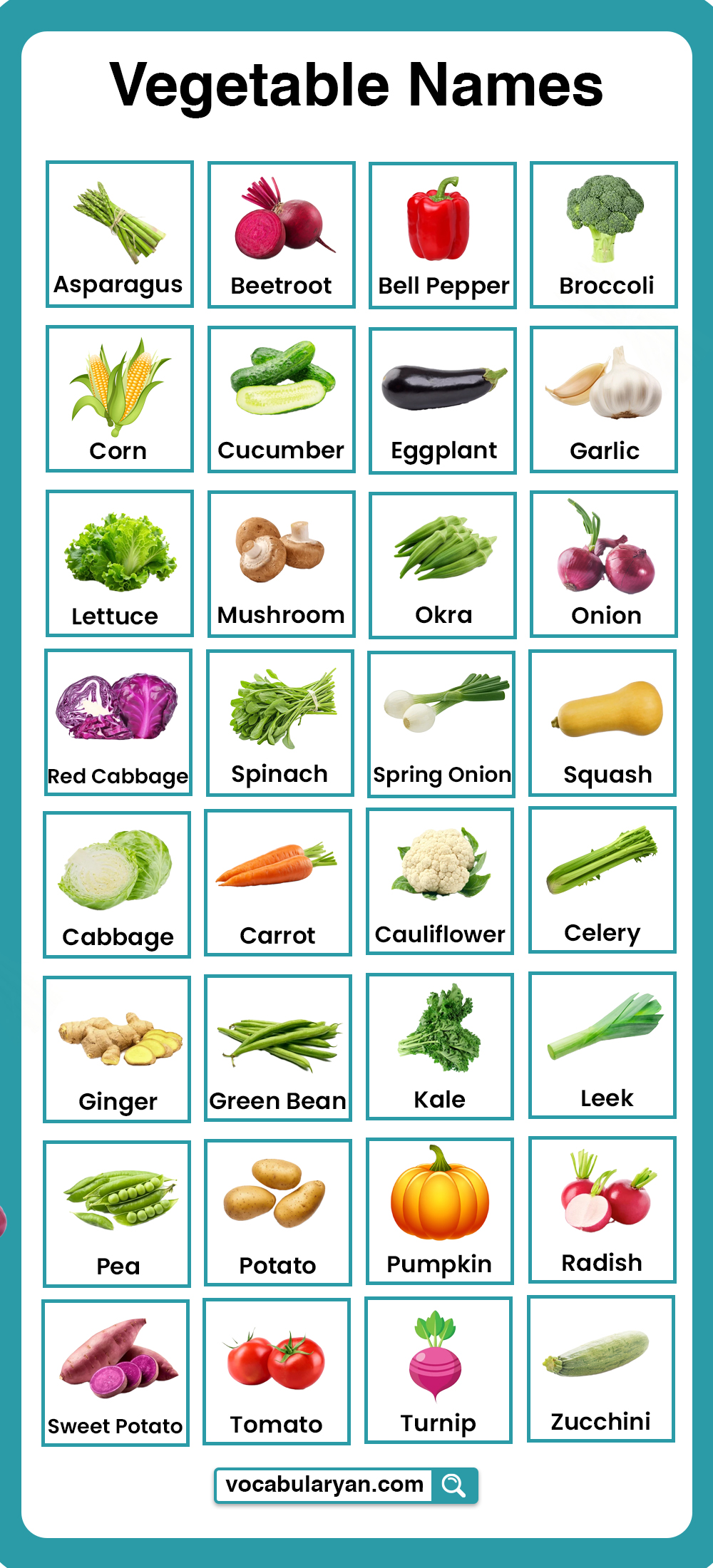Learning vegetable names in English helps students talk about meals, shopping, and everyday kitchen items. It boosts vocabulary through picture-word connection, which is especially useful for kids and ESL learners. This article is organized into easy groups so learners can recognize and remember vegetables by name. With clear lists and matching images, it supports schoolwork, daily use, and fun learning at home.
Common Vegetable Names for Beginners
Basic vegetable names are the most used in homes, schools, and shops. These help you build everyday vocabulary fast.
Below is a list of common vegetables:
- carrot
- potato
- tomato
- onion
- cucumber
- cabbage
- garlic
- capsicum
- chili
- pumpkin
- spinach
- radish
- cauliflower
- brinjal
- peas
- ginger
- turnip
- ladyfinger
- corn
- bitter gourd

Leafy Vegetables and Their English Names
Leafy vegetables are green, light, and common in cooking and garnishing. Learning these supports identification in both cooking and shopping.
Below is a list of leafy vegetables:
- spinach
- lettuce
- cabbage
- kale
- coriander
- mint
- fenugreek leaves
- celery
- mustard greens
- amaranth leaves
- spring onion leaves
- parsley
- water spinach
- chard
Root and Tuber Vegetables in English
Root and tuber vegetables grow underground and are rich in fiber and starch. These names help learners identify cooking staples.
Below is a list of root and tuber vegetables:
- potato
- sweet potato
- carrot
- beetroot
- radish
- turnip
- yam
- cassava
- taro root
- jerusalem artichoke
- parsnip
- lotus root
Vegetables That Grow on the Ground or on Vines
Some vegetables grow close to the soil or on climbing vines. Knowing these supports agricultural and food-based vocabulary.
- pumpkin: A large round vegetable often used in curries or soups
- bottle gourd: Long and pale, cooked with spices or lentils
- bitter gourd: Sharp in taste, used in many traditional meals
- cucumber: Cool and juicy, mostly eaten raw
- zucchini: Looks like cucumber but used in stir-fry
- snake gourd: Long and bendy with pale skin
- ridge gourd: Green and ridged, softens when cooked
- sponge gourd: Soft interior, good in gravy
- ivy gourd: Small and green, cooked with light spices
- chayote: Pear-shaped and crunchy when raw
Vegetable Names Used in Salads
These vegetables are often eaten raw and appear in most salad plates. Learning their names supports diet and menu discussions.
Below is a list of salad vegetables:
- lettuce
- cucumber
- tomato
- carrot
- capsicum
- cabbage
- radish
- onion
- beetroot
- avocado
- sweet corn
- spring onion
Herbs and Spicy Greens Used Like Vegetables
Some green ingredients are technically herbs but behave like vegetables in recipes.
- coriander: Used as topping and for flavor
- mint: Strong smell, used in chutneys and drinks
- parsley: Added for garnish and mild taste
- green chili: Brings heat to dishes
- curry leaves: Fried with oil in many Indian meals
- basil: Used in Italian and Thai food
- dill: Light and thread-like, has a strong smell
- chives: Small stalks with mild onion taste
- lemongrass: Strong lemon-like scent for soups
Popular Vegetable Names in Daily Cooking
These vegetables are often used in everyday cooking. You’ll find them in curries, snacks, soups, and boiled dishes across many kitchens.
- Onion: Often used at the start of cooking; it builds flavor for savory dishes like curry and stew.
- Tomato: Helps make sauces, gravies, and soups thick and slightly tangy in taste.
- Garlic: Gives meals a bold, sharp taste; used in many dishes to boost flavor quickly.
- Cabbage: Commonly chopped and stir-fried; often used in mixed veggie recipes.
- Brinjal: Also called eggplant; usually fried, roasted, or baked with spices.
- Peas: Small, sweet, and green; mixed into rice or curry for extra taste and texture.
- Spinach: Soft leafy green cooked on its own or blended with lentils in daily meals.
- Carrot: Crunchy and colorful; used in stir-fries, salads, and even rice dishes.
- Beans: Long and green, these are usually cooked with spices in dry or wet curries.
- Okra: A bit sticky when cooked; often deep-fried or stir-fried with light seasoning.
- Cauliflower: White and firm; cooked in dry curries or fried for snacks.
- Green Beans: Slim, crisp, and easy to cook; found in many side dishes and veggie mixes.
Vegetables with Soft Skins or Hard Shells
Understanding texture words improves description power in vocabulary. These vegetables differ by their outer covering.
- zucchini: Thin-skinned and tender
- cucumber: Cool and watery, with a soft skin
- pumpkin: Tough skin, soft inside
- bottle gourd: Smooth outside, soft inside
- ash gourd: Waxy outer layer
- chayote: Slight crunch, pale skin
- bitter gourd: Wrinkled and rough surface
- water chestnut: Hard skin, juicy inside
- taro root: Dry, brown outer layer
- turmeric root: Bright orange core, tough cover
Vegetables That Contain Seeds
Many vegetables have seeds inside, useful for vocabulary around growth, nutrition, and botany.
- tomato
- cucumber
- pumpkin
- brinjal
- chili
- squash
- okra
- bell pepper
- bitter gourd
- peas
- paprika
- zucchini
- bottle gourd
- ash gourd
Uncommon and Rare Vegetable Names
These vegetable names are less common but valuable for deeper learning and vocabulary diversity.
- kohlrabi
- fiddlehead ferns
- romanesco
- celeriac
- tinda
- malabar spinach
- kangkong
- bamboo shoots
- drumstick
- yardlong bean
- tamarillo
- elephant foot yam
- pointed gourd
- chili leaves
Seasonal Vegetable Names by Category
Seasonal vegetable names help in meal planning and market understanding. Grouping them teaches growing habits and freshness.
Winter Vegetable List
- spinach
- carrot
- turnip
- cauliflower
- peas
- mustard greens
- radish
- beetroot
- cabbage
- broccoli
- fenugreek
- spring onions
Hot-Weather Vegetables
- okra
- cucumber
- bottle gourd
- bitter gourd
- ridge gourd
- sponge gourd
- pumpkin
- brinjal
- tomato
- chili
- snake gourd
Rain-Loving Vegetable Types
- turmeric root
- taro root
- elephant foot yam
- malabar spinach
- drumstick
- ash gourd
- kangkong
- cucumber
Learn A to Z Vegetable Names in English
Below is an alphabetical list of vegetable names for picture-based vocabulary building:
- A – ash gourd
- B – beetroot, broccoli, brinjal
- C – cabbage, carrot, cauliflower, cucumber, capsicum, chayote
- D – drumstick, dill
- E – elephant foot yam
- F – fiddlehead ferns, fenugreek
- G – garlic, ginger, green beans
- H – horseradish
- I – ivy gourd
- J – jerusalem artichoke
- K – kale, kohlrabi, kangkong
- L – lettuce, lemongrass
- M – mint, mustard greens, malabar spinach
- N – napa cabbage
- O – onion, okra
- P – potato, peas, parsley, pointed gourd, pumpkin
- Q – quinoa greens
- R – radish, ridge gourd, romanesco
- S – spinach, sweet potato, squash, snake gourd, spring onion
- T – tomato, turnip, tinda, turmeric
- U – ulluco
- V – vegetable marrow
- W – water chestnut, water spinach
- Y – yardlong beans, yam
- Z – zucchini
FAQs
Green vegetables include spinach, kale, lettuce, cabbage, broccoli, peas, and zucchini. These vegetables are rich in fiber and good for health.
You May Also Like




Leave a Comment